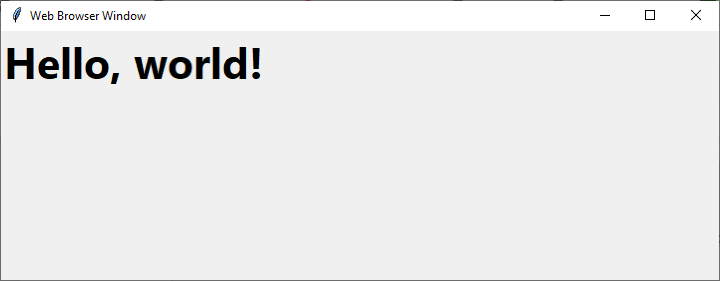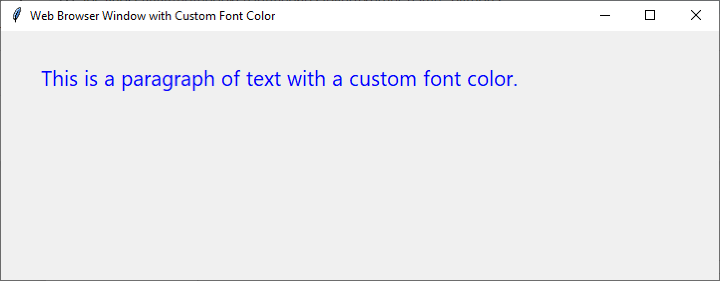
 Data Structure
Data Structure Networking
Networking RDBMS
RDBMS Operating System
Operating System Java
Java MS Excel
MS Excel iOS
iOS HTML
HTML CSS
CSS Android
Android Python
Python C Programming
C Programming C++
C++ C#
C# MongoDB
MongoDB MySQL
MySQL Javascript
Javascript PHP
PHP
- Selected Reading
- UPSC IAS Exams Notes
- Developer's Best Practices
- Questions and Answers
- Effective Resume Writing
- HR Interview Questions
- Computer Glossary
- Who is Who
Add web browser window to Tkinter Window
Tkinter is a popular Python library for creating graphical user interfaces (GUIs). It provides a variety of widgets that allow developers to build interactive applications. However, Tkinter does not include a built-in web browser widget. Nevertheless, with the help of third-party libraries, we can integrate a web browser window into a Tkinter application.
In this article, we will explore how to add a web browser window to a Tkinter window, enabling users to browse websites directly within the application.
Understanding the Web Browser Integration Options
To incorporate a web browser window into a Tkinter application, we have several options to choose from. These options include utilizing the tkhtmlview library, embedding a WebView widget using the tksimplewebview library, or leveraging the pywebview library. Each approach has its advantages and requirements. In this article, we will focus on using the tkhtmlview library, which provides a straightforward solution for displaying web content in a Tkinter application.
Installing the Required Libraries
Before we proceed, let's make sure we have the necessary libraries installed. Open your terminal or command prompt and run the following command to install the tkhtmlview library
pip install tkhtmlview
Integrating the Web Browser Window
Now, let's dive into the steps involved in adding a web browser window to a Tkinter window using the tkhtmlview library.
Step 1: Import the required modules
Start by importing the necessary modules from Tkinter and tkhtmlview.
import tkinter as tk from tkhtmlview import HTMLLabel
Step 2: Create the Tkinter window
Next, create the main Tkinter window that will contain the web browser window.
root = tk.Tk()
root.title("Adding Web Browser Window to Tkinter Window")
Step 3: Create the web browser window
Now, create an instance of the HTMLLabel widget from the tkhtmlview library. This widget will serve as our web browser window.
browser = HTMLLabel(root) browser.pack(fill="both", expand=True)
Step 4: Load a web page
To load a web page into the web browser window, use the set_html method of the HTMLLabel widget. Pass the HTML content or URL of the web page as the argument.
browser.set_html('<h1>Hello, world!</h1>')
In this example, we set the HTML content to a simple "Hello, world!" heading. Alternatively, you can pass the URL of a website to load it dynamically.
Step 5: Run the Tkinter event loop
Finally, start the Tkinter event loop to display the Tkinter window and the embedded web browser window.
root.mainloop()
That's it! With these steps, you have successfully integrated a web browser window into your Tkinter application.
Example
Below is the complete implementation code and its output
import tkinter as tk
from tkhtmlview import HTMLLabel
root = tk.Tk()
root.title("Web Browser Window")
root.geometry("720x250")
browser = HTMLLabel(root)
browser.pack(fill="both", expand=True)
browser.set_html('<h1>Hello, world!</h1>')
root.mainloop()
Output
After running the above code, you will get the web browser window as below

Customizing the Web Browser Window
The HTMLLabel widget from the tkhtmlview library offers various configuration options to customize the appearance and behavior of the web browser window. You can adjust the font, size, and color of the displayed content, handle events like clicking on links, and more. Refer to the tkhtmlview documentation for detailed information on the available options and methods.
Example
Below is a simple example that demonstrates how to add a paragraph of text with custom font color to a Tkinter window using the tkhtmlview library
import tkinter as tk
from tkhtmlview import HTMLLabel
root = tk.Tk()
root.title("Web Browser Window with Custom Font Color")
root.geometry("720x250")
# Create a paragraph of text with custom font color
text = '''
<p style="color: blue; font-size: 16px;">
This is a paragraph of text with a custom font color.
</p>
'''
# Create the HTMLLabel widget to display the text
label = HTMLLabel(root, html=text)
label.pack(pady=30)
root.mainloop()
Output
Upon running the application, you'll see a Tkinter window displaying the paragraph of text with the specified font color and style.

Conclusion
In conclusion, integrating a web browser window into a Tkinter application opens a world of possibilities for developers. By utilizing the tkhtmlview library, we can seamlessly incorporate web browsing capabilities into our Tkinter GUIs. This not only enhances the functionality of our applications but also provides users with a more immersive and convenient browsing experience.
The step-by-step process outlined in this article allows developers to quickly add a web browser window to their Tkinter windows. With just a few lines of code, we can create a Tkinter window, embed the HTMLLabel widget as our web browser window, and load web content. The tkhtmlview library simplifies the integration process and provides options for customizing the appearance and behavior of the web browser window to suit our specific requirements.

